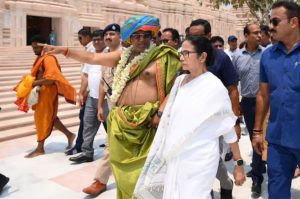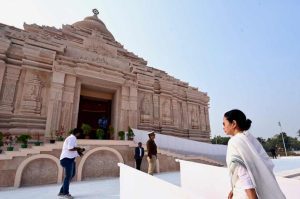Jagannath Temple Digha: The ₹250 crore Jagannath Temple in Digha, West Bengal, will be inaugurated on Akshaya Tritiya, April 30, 2025. Discover its architecture, rituals, tourism potential, and cultural impact.

The Jagannath Temple in Digha, West Bengal, is all set to be inaugurated on April 30, 2025, a day that also marks Akshaya Tritiya, one of the most auspicious days in the Hindu calendar. Spearheaded by the West Bengal state government, this temple is not only an architectural marvel but also a vision of spiritual renaissance and regional pride.
A Temple Born from Vision and Devotion
The concept of building a Jagannath Temple in Digha was first floated several years ago by the West Bengal Chief Minister Mamata Banerjee, who wanted to give the state a pilgrimage site that reflects its cultural depth and spiritual aspirations.
Located in East Midnapore district, Digha is a popular seaside tourist destination, and the new temple seeks to enhance this appeal by transforming the region into a major religious tourism hub.
With a whopping ₹250 crore budget, entirely funded by the state government, the project has been carefully planned and executed over several phases. The temple will officially open its gates to the public on April 30, when special rituals, cultural programs, and live broadcasts will mark the grand consecration.
“According to the West Bengal Tourism Development Corporation, new spiritual tourism circuits will connect Digha with Mandarmani, Tajpur, and Talsari.”
Jagannath Temple Digha: Key Highlights
- Location: Digha, East Midnapore, West Bengal
- Inauguration Date: April 30, 2025 (Akshaya Tritiya)
- Budget: ₹250 crore
- Funded By: Government of West Bengal
- Complex Size: 22 acres
- Architecture: Replica of Jagannath Temple, Puri
- Rituals Managed By: Sanatan Trust, ISKCON, local priests
- Live Broadcast: LED screens in various Bengal districts
- Expected Visitors: Over 10 lakh annually
Architectural Brilliance: A Tribute to the Puri Model
One of the most fascinating aspects of the Jagannath Temple Digha is its design. Modeled after the iconic Jagannath Temple in Puri, Odisha, this structure replicates the grandeur and traditional craftsmanship while incorporating modern construction techniques and disaster-resilient materials to withstand coastal conditions.
The temple stands tall at a height equal to its Puri counterpart, making it visible from afar. The shikhara (tower) has been adorned with intricate carvings representing various deities, floral motifs, and mythological themes.
Additionally, the temple premises include:
- Administrative buildings
- Rest houses for pilgrims
- A dedicated space for Rath Yatra
- Shops and stalls for local artisans and SHGs
- A police outpost and fire safety infrastructure
The structure, built on a 22-acre campus, promises to be one of the largest religious complexes in Eastern India.
Consecration on Akshaya Tritiya: The Symbolism
Akshaya Tritiya is considered one of the most spiritually significant days in Hinduism. According to tradition, any good deed done on this day is believed to bring eternal blessings.
The state government has aligned the temple inauguration with this date to emphasize the eternal value and auspiciousness of the temple’s offerings. From special pujas to recitations from the Vedas, a series of elaborate rituals will take place in the presence of spiritual leaders, dignitaries, and thousands of devotees.
“The Digha-Shankarpur Development Authority has played a key role in preparing infrastructure around the temple to support large crowds.”
Chief Minister Mamata Banerjee’s Role and Vision


Although not a formal member of the temple trust, Chief Minister Mamata Banerjee has played a central role in turning this vision into a reality. She has:
- Personally funded the purchase of a golden broom to be used during the temple’s Rath Yatra, symbolizing humility and service.
- Ensured the project was fully state-funded without reliance on private donations or central assistance.
- Emphasized inclusivity and transparency by including representatives from ISKCON, Sanatan Trust, local religious leaders, and government officials in the temple’s 20-member trustee board.
- Advocated for women’s empowerment by allowing women-led self-help groups (SHGs) to set up shops in the temple premises.
She has publicly stated:
“The Jagannath Temple in Digha is not just a spiritual site, it’s Bengal’s gift to India and the world. It reflects our cultural soul, architectural prowess, and the strength of community devotion.”


“Chief Minister Mamata Banerjee, as per updates on the official West Bengal government portal, emphasized that this is a people’s temple, built with public vision and public funds.”
Trust Board: Management and Governance
To ensure smooth functioning, the temple will be governed by a Temple Trust Board chaired by the Chief Secretary of West Bengal. Members include:
- Senior IAS officers
- ISKCON and Sanatan Trust members
- Local Digha municipality representatives
- Temple priests from Bengal and Odisha
- Cultural historians and religious scholars
The trust will oversee:
- Temple rituals and festivals
- Maintenance of the premises
- Pilgrim facilities
- Security and crowd management
- Training of temple staff and volunteers
Economic and Cultural Impact on Digha
The construction of the Jagannath Temple Digha is poised to transform the region both economically and culturally:
Tourism Boom
- The temple is expected to attract over 10 lakh tourists annually.
- It will boost hotels, restaurants, handicraft businesses, and transport services.
- Special tourist circuits are being planned by the Tourism Department to connect Digha with Mandarmani, Talsari, Tajpur, and other nearby destinations.
Empowering Local Communities
- Women’s self-help groups (SHGs) will sell puja items, handicrafts, and snacks.
- Local artisans will be given space to exhibit traditional Bengal craftsmanship.
- Temporary employment for construction workers and permanent jobs for temple staff, security, and maintenance crews have already started transforming lives.
Education and Culture
- Plans are underway to build a Vedic study center and a cultural auditorium within the premises.
- Local schools and colleges will be involved in hosting spiritual debates, essay contests, and educational tours to the temple.
Rath Yatra at Digha: From 2025 Onward
One of the most exciting developments is that from 2025 onwards, Digha will host its own Jagannath Rath Yatra—modeled on the Puri festival. A grand chariot is being constructed for the procession, and thousands of devotees are expected to participate every year.
This not only adds religious vibrancy but also helps decongest the Puri temple during the monsoon month of Ashadha, offering Bengali devotees a local alternative.
Broadcast and Accessibility: Devotion from Afar
To make the inauguration inclusive, the government plans a statewide live broadcast:
- LED screens to be set up in every district, especially in remote and tribal areas.
- The consecration ceremony will also be broadcast on Doordarshan and private TV channels, along with online streaming on YouTube and social media platforms.
Additionally, special trains and buses will run from Kolkata, Asansol, Siliguri, and Burdwan to Digha to facilitate travel for pilgrims.
Environmental Measures: A Green Temple Initiative
Given its coastal location, eco-sustainability was built into the design philosophy:
- Solar power systems for lighting and temperature regulation
- Rainwater harvesting units
- Zero-discharge waste management plant
- Green belts and landscaped gardens
This will help the Jagannath Temple Digha maintain its operations without harming the fragile coastal ecosystem.
A Religious and Political Message
The temple project has also sparked discussions about the political motives behind it. Some political analysts suggest:
- It’s a strategic move to counter BJP’s influence using soft Hindutva.
- By replicating Odisha’s Puri model, TMC is appealing to Hindu sentiments without compromising its secular image.
- The focus on women’s empowerment and rural employment ties the temple’s narrative to development politics.
However, the Chief Minister has vehemently denied any political motives, stating:
“This is about Bengal’s devotion, not politics. Our culture belongs to everyone.”
Public Reactions and Pilgrim Preparations
Social media is abuzz with excitement:
- Devotees are planning group trips.
- Tour operators are offering Jagannath Temple Digha travel packages.
- Temples across West Bengal are organizing buses for the inauguration.
Prominent cultural personalities, including poets, musicians, and film actors, have hailed the temple as a symbol of Bengal’s inclusive spirituality.
What Lies Ahead for Jagannath Temple Digha
With the April 30 inauguration, the Jagannath Temple Digha will officially become:
- A major pilgrimage site in Eastern India
- A tourism and cultural hotspot
- A platform for regional economic empowerment
- A symbol of state-led religious development
In the years to come, the state government plans to introduce:
- Annual Jagannath Cultural Festival
- Weekend spiritual retreats
- Interfaith dialogue forums
- Heritage tourism collaboration with Odisha
The Jagannath Temple in Digha is not just a spiritual sanctuary—it’s a bold cultural statement, a tourism booster, and a heartfelt tribute to Bengal’s devotional legacy.
With its grand inauguration on April 30, 2025, the temple is set to put Digha on India’s spiritual map, offering millions of devotees a place of peace, beauty, and profound connection with Lord Jagannath.
Also read: Home | Channel 6 Network – Latest News, Breaking Updates: Politics, Business, Tech & More

